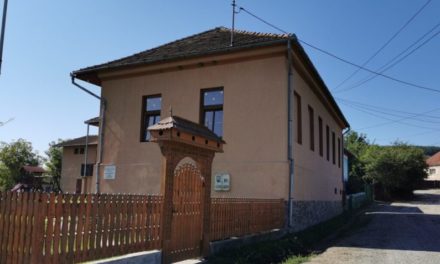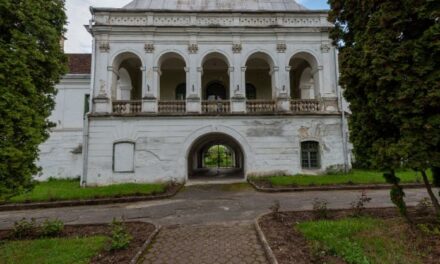Michel van Langeveld, who is now only known to everyone as Misi Holland, moved to Szék from the Netherlands 19 years ago, at the age of 52, to finally live the way he really wanted: in an old, traditional house, in a village where silence and peace reside , where most people still wore national costumes every day, there was no drinking water, gas, or sewerage, you could only bathe in rainwater or in the salty lakes in the area. He was also impressed by the beauty and untouched nature of the landscape, but another strong link was Hungarian folk music and folk dance. Ferenc Balla, the director of the Kallós Zoltán Foundation, spoke with the Szék traditionalist as part of the Hungarian Days in Cluj.
Michel van Langeveld was the guest of the Hungarian Days in Cluj on Wednesday afternoon in the Youth Court, who talked about how he came to Szék almost twenty years ago, what attracts him to the Transylvanian landscapes, how 564 pairs of boots were collected in his house in Szék, and what the current Szék is like. As he said, his journey led him to the Transylvanian village thanks to the folk dance. In 1980, she started attending an amateur dance group in her country, where they learned the dance of a different nation every week. In 1985, the Hungarian dance hall education started in Utrecht, the Netherlands, where he later went regularly.
"At the beginning I wanted to go home, the Szatmár dance was so difficult, but then in the end they beat me and did it very well. The first dance I learned, the Széki, was slow, which is probably why Széki stayed in my heart so much. Everyone found that dance boring, but I really enjoyed it"
he recalled.
Even then, he found the Hungarian dance very special, as he says, very different from the Dutch clog dance. "The Dutch dance is over after 3-4 minutes, and the Hungarian dance only really begins then, and a field dance can last up to half an hour. Hungarian dance is very special, dance, music and couples are in harmony with each other, and the same rhythm can be discovered in many songs," he pointed out.
It was a defining experience for him when he accidentally came across Péter Korniss's photo album presenting Hungarian folk customs in an antique shop in Amsterdam, which he liked so much that he returned to the antique shop a few days later to buy 15 more copies of the book. It was in this photo album that he met Szék for the first time and wondered "how so many people could fit into the hall of a small dance hall in Szék". After that, he visited dance halls in Hungary for years, and he reached Transylvania for the first time after the regime change. He visited Kalotaszentkirály, Szék, Jobbágytelke, Felsősófalva, Gyimesközéplok, but he also visited the villages of Csángó, and everywhere - following Péter Korniss - he took pictures and videos. He returned to Szék every year, always stayed in the same place, and became more and more attached to the small village.
Finally, he decided to completely liquidate his presence in the Netherlands after 14 years.
In 2004, he bought and renovated a house condemned to be demolished, which once housed the Csipkeszeg dance hall, and organized his collection there. Since then, he has renovated several houses, so if you go to Szék today, you can see the permanent photo exhibition of Péter Korniss in addition to the landscape house.
564 pairs of boots
Even today, many foreign and Hungarian tourists come to the Holland Misi museum to get to know Szék's traditional culture, and the host tells them with great love about the old Szék, when most people went to work in Széki every day, folk dancing flourished and spinning was part of the order of life. harvest.
Through the Csipkeszeg Foundation he established, he regularly organizes a dance hall, folk music and folk dance teaching programs.
During the presentation, it was also revealed why there are so many old chair boots hanging on the porch of Michel Van Langeveld's house. As he said, ten years ago he decided to buy some traditional széki boots for the exhibition. He told his neighbor, Aunt Sári, that he would give a packet of Dutch coffee for a pair of old boots, so the next day he bought the first pair. A day later, two more villagers approached him with another pair of boots, and it has continued like this ever since. Misi Holland is constantly buying footwear, so today she is the proud owner of 564 pairs of boots.
Misi Holland commented on what Szék's scene is like:
the coronavirus caused a lot of trouble in Szék, and unfortunately today's young people don't dance much in the village anymore.
You can no longer see so many people dressed in folk costumes in Szék, and the village is no longer as bustling, as many people are looking for a living in the city or in other countries. But he is not discouraged by this, according to what he says, he does not focus on the bad, but only on the good, and continues to do his work, thus keeping the folk culture of Széki alive. It seems that Szék has many sights to see, there are the reeds, the salt lakes, the Reformed church, and the Bánffy Castle is not far away, which is why the village is still popular among tourists today.
Source: maszol.ro
Cover photo: Anna Lőrincz / maszol.ro













